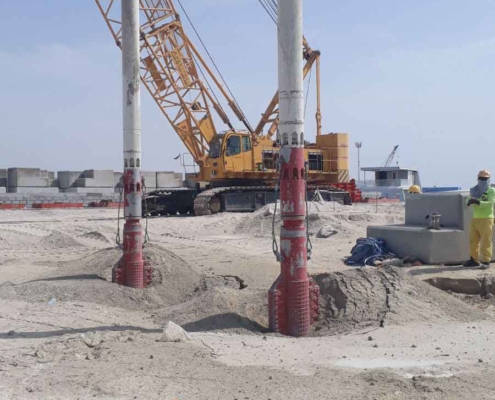Published: 5 November 2019
OMS Pile Driving Equipment GmbH. provides a large selection of ground improvement techniques: “vibro compaction”, “vibro replacement” and “vertical drain”. As effective as our products are, choosing the correct equipment for your project might be a challenge. However, our experts on ground engineering can help you to decide on the best equipment for your project.
Today, social and industrial growth has increased the importance of ground engineering. The profession plays a crucial role in projects such as power stations or the expansion of infrastructure systems like harbours and airports. Therefore, it is good to consult an expert before deciding on the method of ground improvement.
METHODS
Deep vibro compaction and vibro replacement methods are mainly to increase the strength of granular soils as well as unfavourable soil conditions. They are also beneficial for the improvement of deformation characteristics of the same type of soil. The two methods work by enhancing the bearing capacity of the weak layer. Then, they utilize the benefit of improved resistance. Ergo, this results in a transition between the deep foundation and soil stabilization. This way, the transition ensures structural support below or on the improved ground surface both safety and economy-wise.
As OMS team, we support our customers by recommending the best soil improvement equipment solutions. Vibro compaction and vibro replacement (stone columns), as well as vertical drain (wick drain) equipment of OMS, have proved themselves in the global market from Europe to the Middle East, South East Asia and America continent.
VIBRO COMPACTION – TOP FEED GROUND IMPROVEMENT TECHNIQUE
Vibro compaction method is mostly suitable for fine granular soils with seismic risk. For this reason, experts suggest for land reclamation projects to decrease the risk of liquefaction. Furthermore, the technique is useful for the densification of sand-like soils on-site through an OMS Vibroflotation prob. Due to the concurrent impact of saturation and vibration, loose sand particles change into a more compact state. As a result, lateral confining pressure of the sand mass rises.
Vibro compaction top feed technique is convenient for medium to coarse-grained sand with silt content. Cohesive soils with silt and clay do not respond to vibratory compaction. The illustration below explains the operation:
Vibro Compaction
Tandem Free Hanging Ground Improvement:
The tandem vibro compaction includes two vibroflotation probes. Each prob suspends from the same crane. Land reclamation projects that require 20 – 25 m depth uses this configuration. The quality of compaction/stone column is controllable with a data logger supplied by OMS. Thence, the depth, compaction rate, time-related compaction and withdrawals can be measured and monitored. The data logger is also able to measure the gravel volume.
Single Free Hanging Ground Improvement:
The single free-hanging vibroflotation probe consists of the same interchangeable parts as Tandem. The depth of compaction can be deeper. Correspondingly, medium to small scale projects can be executed with a single free hanging system. Compared to the Tandem system, crane capacity of the vibroflotation probe is slightly smaller. Similarly to Tandem, the quality of compaction can be monitored with a “data logger” so that, depth, compaction rate, time-related compaction and withdrawals as well as gravel volume can be measured and monitored.
VIBRO REPLACEMENT – BOTTOM FEED GROUND IMPROVEMENT TECHNIQUE
Vibro replacement stone column is a system where vertical columns made out of compacted gravels are placed into the soil. This technique builds load-bearing columns and these columns are made out of gravels or crushed stones in a cohesive soil and granular soil with high fines content.
Vibro replacement columns are beneficial for enhancing a wide range of soil types. They can improve very soft clays and peat to materials suitable for the vibro compaction method. The equipment of the vibro replacement method is identical to the one in the vibro compaction method. However, vibro displacement equipment is slightly different.
As for the operation of stone/gravel columns, there are two methods: the top feed and the bottom-feed. The latter operation will be issued in this part. “The bottom-feed” process feeds gravels from the end of the prob with pressurized air. To achieve optimum performance, OMS has developed the vibroflotation probe and gravel hooper with the pressure chamber. Additionally, these OMS vibroflotation probes can mount on an existing drill rig or leader, crane or an excavator.

Vibro Replacement by Stone Columns
Drill Rig / Leader Mounted Ground Improvement:
The OMS vibroflotation probe (bottom feed system) with gravel hooper can mount on an existing drill rig or a leader. For this action, a supervisor from the OMS technical team is needed. This configuration is useful because of the drill rig or leader equipped with a pull-down system. This system allows an additional pull-down pressure during compaction and penetration.
Bottom Feed Free Hanging Ground Improvement:
The OMS vibroflotation probe (bottom feed system) with a gravel hooper. The system is suspended from a crane. The crane capacity must be able to carry the suspended weights for the configuration to work.
Excavator Mounted Bottom Feed Ground Improvement Technique:
This ground improvement technique is easier to mount on a customers’ excavator. In any case, the help of OMS supervision team is needed. Also, it is simpler to operate and cost-friendly. However, stone columns come with limited depth. Excavator selection is crucial in this configuration.
Read more to learn about OMS Pile Driving Equipment!
Vibro Hammer Production Process
Ask Also Other Rental-Used Pile Driver
SlideShare Presentation about Ground Improvement Techniques
https://www.omsvibro.com/ground-improvement-techniques/
Categories
Deep Dynamic Compaction, Grouting, Stabilization, Deep Soil Mixing, Ground Freezing, Lime Stabilization, Prefabricated Vertical Drains, Rammed Aggregate Piers
Keywords
Hammers, Construction, Deep Foundations, Ground Improvement


















